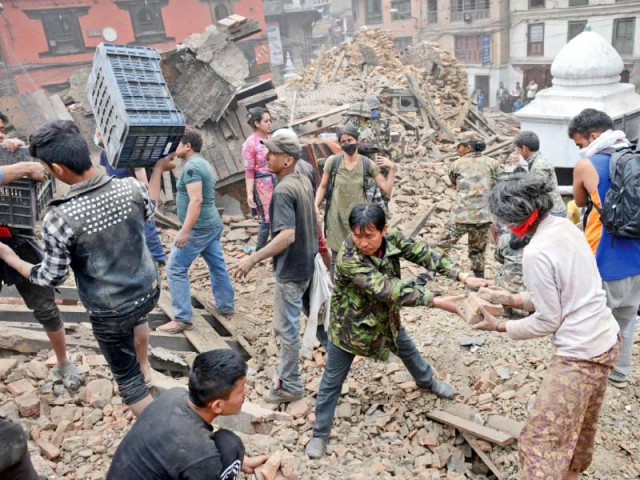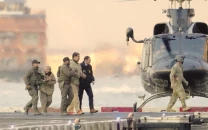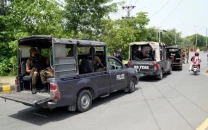Quake flattens Nepal cities, shakes Everest
Over 1,300 dead; many more fatalities feared as Kathmandu appeals for foreign help .

People clear rubble in Kathmandu’s Durbar Square that was severely damaged by the earthquake on Saturday. PHOTO: AFP
A powerful earthquake struck Nepal and sent tremors through northern India on Saturday, killing more than 1,300 people, touching off a deadly avalanche on Mount Everest and toppling a 19th-century tower in the capital Kathmandu.
There were reports of devastation in outlying, isolated mountainous areas after the midday quake of magnitude 7.9, Nepal’s worst in 81 years, centred 80km east of the second city, Pokhara.
As fears grew of a humanitarian disaster in the impoverished Himalayan nation of 28 million, an overwhelmed government appealed for foreign help. India was first to respond by sending in military aircraft with medical equipment and relief teams.
A police spokesman said the death toll in Nepal alone had reached 1,341, about half of them in the Kathmandu Valley. A further 36 fatalities were reported in northern India, 12 in Chinese Tibet and four in Bangladesh.
The quake was more destructive for being shallow, toppling buildings, opening gaping cracks in roads and sending people scurrying into the open as aftershocks rattled their damaged homes.
Thousands prepared to spend the night outside, setting up makeshift tents, sitting around campfires and eating food provided by volunteers.
Indian tourist Devyani Pant was in a Kathmandu coffee shop with friends when “suddenly the tables started trembling and paintings on the wall fell on the ground. “I screamed and rushed outside,” she told Reuters by telephone from the capital, where at least 300 people died.

“We are now collecting bodies and rushing the injured to the ambulance. We are being forced to pile several bodies one above the other to fit them in.”
An Indian army mountaineering team found 18 bodies on Mount Everest, where an avalanche unleashed by the earthquake swept through the base camp. More than 1,000 climbers had gathered there at the start of the climbing season. Choti Sherpa, who works at the Everest Summiteers Association, was unable to call her family and colleagues on the mountain. “Everyone is trying to contact each other, but we can’t,” she said. “We are all very worried.”
A second tourism official, Mohan Krishna Sapkota, said it was “hard to even assess what the death toll and the extent of damage” around Everest could be. “The trekkers are scattered all around the base camp and some had even trekked further up. It is almost impossible to get in touch with anyone.”
Around 300,000 foreign tourists were estimated to be in various parts of Nepal for the spring trekking and climbing season in the Himalayas, and officials were overwhelmed by calls from concerned friends and relatives.
Among the Kathmandu landmarks destroyed by the quake was the 60-metre-high Dharahara Tower, built in 1832 for the queen of Nepal, with a viewing balcony that had been open to visitors for the last 10 years.
A jagged stump just 10 metres high was all that was left of the lighthouse-like structure. As bodies were pulled out of the ruins, a policeman said up to 200 people had been trapped inside.
The Everest avalanches, first reported by climbers, raised fears for those on the world’s loftiest peak a year after a massive snowslide killed 16 Nepali guides just above base camp.
Romanian climber Alex Gavan tweeted that there had been a “huge earthquake then huge avalanche” at the base camp, forcing him to run for his life. In a later tweet Gavan made a desperate appeal for a helicopter to fly in and evacuate climbers who had been hurt: “Many dead. Much more badly injured. More to die if not heli asap.”
Published in The Express Tribune, April 26th, 2015.



















COMMENTS
Comments are moderated and generally will be posted if they are on-topic and not abusive.
For more information, please see our Comments FAQ